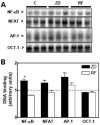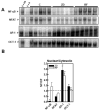Gestational zinc deficiency affects the regulation of transcription factors AP-1, NF-κB and NFAT in fetal brain
- PMID: 20092996
- PMCID: PMC3506428
- DOI: 10.1016/j.jnutbio.2009.09.003
Gestational zinc deficiency affects the regulation of transcription factors AP-1, NF-κB and NFAT in fetal brain
Abstract
Transcription factors AP-1, nuclear factor κB (NF-κB) and NFAT are central to brain development by regulating the expression of genes that modulate cell proliferation, differentiation, apoptosis and synaptic plasticity. This work investigated the consequences of feeding zinc-deficient and marginal zinc diets to rat dams during gestation on the modulation of AP-1, NF-κB and NFAT in fetal brain. Sprague-Dawley rats were fed from gestation day (GD) 0 a control diet ad libitum (25 μg zinc/g diet, C), a zinc-deficient diet ad libitum (0.5 μg zinc/g diet, ZD), the control diet in the amounts eaten by the ZD rats (restrict fed, RF) or a diet containing a marginal zinc concentration ad libitum (10 μg zinc/g diet, MZD) until GD 19. AP-1-DNA binding was higher (50-190%) in nuclear fraction isolated from ZD, RF and MZD fetal brains compared to controls. In MZD fetal brain, high levels of activation of the upstream mitogen-activated protein kinases JNK and p38 and low levels of ERK phosphorylation were observed. Total levels of NF-κB and NFAT activation were higher or similar in the ZD and MZD groups than in controls, respectively. However, NF-κB- and NFAT-DNA binding in nuclear fractions was markedly lower in ZD and MZD fetal brain than in controls (50-80%). The latter could be related to zinc deficiency-associated alterations of the cytoskeleton, which is required for NF-κB and NFAT nuclear transport. In summary, suboptimal zinc nutrition during gestation could cause long-term effects on brain function, partially through a deregulation of transcription factors AP-1, NF-κB and NFAT.
Copyright © 2010 Elsevier Inc. All rights reserved.
Figures




References
-
- Scheplyagina LA. Impact of the mother's zinc deficiency on the woman's and newborn's health status. J Trace Elem Med Biol. 2005;19:29–35. - PubMed
-
- Briefel RR, Bialostosky K, Kennedy-Stephenson J, McDowell MA, Ervin RB, Wright JD. Zinc intake of the U.S. population: findings from the third National Health and Nutrition Examination Survey, 1988-1994. J Nutr. 2000 May;130:1367S–73S. - PubMed
-
- Wada L, King JC. Trace element nutrition during pregnancy. Clin Obstet Gynecol. 1994 Sep;37:574–86. - PubMed
-
- Caulfield LE, Zavaleta N, Shankar AH, Merialdi M. Potential contribution of maternal zinc supplementation during pregnancy to maternal and child survival. Am J Clin Nutr. 1998 Aug;68:499S–508S. - PubMed
Publication types
MeSH terms
Substances
Grants and funding
LinkOut - more resources
Full Text Sources
Medical
Research Materials
Miscellaneous

